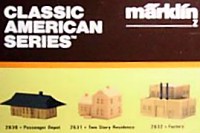Z Scale Shelf Layout
Layout Summary
Setting: |
Pennsylvania, early diesel era |
Scale: |
Z |
Size: |
16 by 28 inches |
Track: |
sectional Märklin |
Control: |
not selected |
Benchwork: |
Foamcore |
Scenery: |
Sculptamold over Foamcore |
Year: |
1991 |
Status: |
finished |
Disposition: |
long gone |
Rebound Modeling

Freshly divorced and living in a brand new condo, I struggled to find a new modeling direction. As a stop-gap, I decided to dabble in Z Scale for a while, and built a small shelf layout. Two things inspired this direction: Micro-Trains' line of American Z Scale locos and rolling stock (which they'd bought from a small-time independent developer), and Märklin's solid cast resin "Classic American Series" structures.
Although the layout was never named, the setting was a tiny Pennsylvania coalmine town on an obscure branchline of the Pennsylvania Railroad—simply because my one and only locomotive at the time was a Micro-Trains PRR F unit. All of the structures were modified to give them fresh character and reduce their solid-block feel.

The freight depot (1), originally a feed mill, lost its tallest peak but gained a corrugated metal roof over the loading dock; a string of microbulbs under the loading dock roof and some freight and figures on the dock gave this building life. Next, the passenger station (2, #2630) was illuminated by separating the structure's two parts and milling out slots for bulbs in the underside of the roof with a Dremel tool. The reassembled structure sat on a piece of scribed sheet styrene to give it a proper platform.
The factory (3, #2632) and the row of stores (4) bracketed a street that ended in a special surface mirror assembly (5) designed to create the illusion that the street continued though another intersection. The factory interior was partially carved out using a circular saw so that the main freight doors could be left open. To illuminate all of the many windows in the row of stores, I painted the entire structure except for the windows with a dense coat of flat black paint, then applied final colors over the black. Then I drilled out a series of holes in the middle of the casting block and installed bright lights, which shone through the semi-translucent white casting material, giving all of the windows a soft glow.
The two houses (6, #2631) were drilled and milled to physically open up some of the windows, which were glazed and illuminated. One house got a canopy over the door with a microbulb powered through the brass rod posts, and both houses got driveways, trimmed hedges and mailboxes. Behind them, the track leading to the mine (7) followed an incline so that the siding was elevated above the mainline. The lower half of this incline, as well as the back stretch of the loop, were hidden from view behind a dense row of trees along the dotted green line (8).
A sky mural cut from a poster was placed on the wall behind the layout, which sat on shelf brackets set at eye level. When you stood with your head within the recess in the middle, you were rewarded with a nearly 270-degree panoramic view, which was quite enveloping for a layout measuring less than one by three feet.
There are no photos of the layout, since (strangely) I didn't own a camera at the time.
